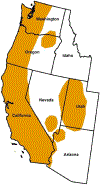History of the geographic distribution of the western blacklegged tick, Ixodes pacificus, in the United States
- PMID: 38387162
- PMCID: PMC10960675
- DOI: 10.1016/j.ttbdis.2024.102325
History of the geographic distribution of the western blacklegged tick, Ixodes pacificus, in the United States
Abstract
Ixodes pacificus (the western blacklegged tick) occurs in the far western United States (US), where it commonly bites humans. This tick was not considered a species of medical concern until it was implicated in the 1980s as a vector of Lyme disease spirochetes. Later, it was discovered to also be the primary vector to humans in the far western US of agents causing anaplasmosis and hard tick relapsing fever. The core distribution of I. pacificus in the US includes California, western Oregon, and western Washington, with outlier populations reported in Utah and Arizona. In this review, we provide a history of the documented occurrence of I. pacificus in the US from the 1890s to present, and discuss associations of its geographic range with landscape, hosts, and climate. In contrast to Ixodes scapularis (the blacklegged tick) in the eastern US, there is no evidence for a dramatic change in the geographic distribution of I. pacificus over the last half-century. Field surveys in the 1930s and 1940s documented I. pacificus along the Pacific Coast from southern California to northern Washington, in the Sierra Nevada foothills, and in western Utah. County level collection records often included both immatures and adults of I. pacificus, recovered by drag sampling or from humans, domestic animals, and wildlife. The estimated geographic distribution presented for I. pacificus in 1945 by Bishopp and Trembley is similar to that presented in 2022 by the Centers for Disease Control and Prevention. There is no clear evidence of range expansion for I. pacificus, separate from tick records in new areas that could have resulted from newly initiated or intensified surveillance efforts. Moreover, there is no evidence from long-term studies that the density of questing I. pacificus ticks has increased over time in specific areas. It therefore is not surprising that the incidence of Lyme disease has remained stable in the Pacific Coast states from the early 1990s, when it became a notifiable condition, to present. We note that deforestation and deer depredation were less severe in the far western US during the 1800s and early 1900s compared to the eastern US. This likely contributed to I. pacificus maintaining stable, widespread populations across its geographic range in the far western US in the early 1900s, while I. scapularis during the same time period appears to have been restricted to a small number of geographically isolated refugia sites within its present range in the eastern US. The impact that a warming climate may have had on the geographic distribution and local abundance of I. pacificus in recent decades remains unclear.
Keywords: Geographic distribution; Ixodes pacificus; United States.
Published by Elsevier GmbH.
Conflict of interest statement
Declaration of competing interest None
Figures



Similar articles
-
Changes in the geographic distribution of the blacklegged tick, Ixodes scapularis, in the United States.Ticks Tick Borne Dis. 2023 Nov;14(6):102233. doi: 10.1016/j.ttbdis.2023.102233. Epub 2023 Jul 24. Ticks Tick Borne Dis. 2023. PMID: 37494882 Free PMC article. Review.
-
Lyme disease risk in southern California: abiotic and environmental drivers of Ixodes pacificus (Acari: Ixodidae) density and infection prevalence with Borrelia burgdorferi.Parasit Vectors. 2017 Jan 5;10(1):7. doi: 10.1186/s13071-016-1938-y. Parasit Vectors. 2017. PMID: 28057067 Free PMC article.
-
Prevalence of five human pathogens in host-seeking Ixodes scapularis and Ixodes pacificus by region, state, and county in the contiguous United States generated through national tick surveillance.Ticks Tick Borne Dis. 2023 Nov;14(6):102250. doi: 10.1016/j.ttbdis.2023.102250. Epub 2023 Sep 11. Ticks Tick Borne Dis. 2023. PMID: 37703795 Free PMC article.
-
Lake Michigan insights from island studies: the roles of chipmunks and coyotes in maintaining Ixodes scapularis and Borrelia burgdorferi in the absence of white-tailed deer.Ticks Tick Borne Dis. 2021 Sep;12(5):101761. doi: 10.1016/j.ttbdis.2021.101761. Epub 2021 Jun 6. Ticks Tick Borne Dis. 2021. PMID: 34167044 Free PMC article.
-
Evaluation of the association between climate warming and the spread and proliferation of Ixodes scapularis in northern states in the Eastern United States.Ticks Tick Borne Dis. 2024 Jan;15(1):102286. doi: 10.1016/j.ttbdis.2023.102286. Epub 2023 Nov 27. Ticks Tick Borne Dis. 2024. PMID: 38016209 Free PMC article. Review.
Cited by
-
Investigating the prevalence of three medically important pathogens in Ixodes pacificus from southern Oregon.Front Parasitol. 2025 Jun 20;4:1599377. doi: 10.3389/fpara.2025.1599377. eCollection 2025. Front Parasitol. 2025. PMID: 40620357 Free PMC article.
-
Predicting the potential global distribution of Ixodes pacificus under climate change.PLoS One. 2024 Aug 27;19(8):e0309367. doi: 10.1371/journal.pone.0309367. eCollection 2024. PLoS One. 2024. PMID: 39190767 Free PMC article.
References
-
- Adams KP, Hamilton RJ, 2011. Management history. In: Hewitt DG (Ed.), Biology and Management of White-Tailed Deer. CRC Press, New York, NY, USA, pp. 355–377.
-
- Allred DM, Beck DE, White LD, 1960. Ticks of the genus Ixodes in Utah. Brigham Young Univ. Sci. Bull. Biol. Ser 1 (4), 1.
-
- Allred DM, Beck DE, Jorgensen CD, 1963a. Nevada test site study areas and specimen depositories. Brigham Young Univ. Sci. Bull. Biol. Ser 2 (4), 1.
-
- Allred DM, Beck DE, Jorgensen CD, 1963b. Biotic communities of the Nevada test site. Brigham Young Univ. Sci. Bull. Biol. Ser 2 (2), 1.
Publication types
MeSH terms
Grants and funding
LinkOut - more resources
Full Text Sources
Medical

